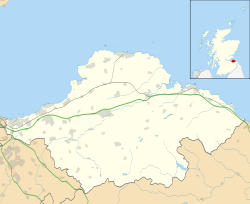| RAF Drem West Fenton Aerodrome Gullane Aerodrome | |
|---|---|
| Drem, East Lothian, Scotland | |
| Type | Royal Air Force station |
| Site information | |
| Owner |
Air Ministry Admiralty |
| Controlled by |
|
| Site history | |
| Built | 1917 |
| In use | 1917-1946 |
| Battles/wars | Second World War |
| Garrison information | |
| Garrison | RAF Fighter Command |
Royal Air Force station Drem or more simply RAF Drem is a former Royal Air Force station, just north of the village of Drem in East Lothian, Scotland. The motto of the station was Exiit Hinc Lumen which means "Ascend from this Light".
History
The foundation of Drem as an air base, precedes the creation of the Royal Air Force (RAF) as by 1916, an airfield had been established under the name West Fenton Aerodrome. From 1916 to 1917, No. 77 Home Defence Squadron, Royal Flying Corps operated from Drem and in April 1918, No. 2 Training Depot Station opened.
Between April and 14 August 1918, the American 41st Aero Squadron under the command of Lieut. Warren C. Woodward were temporarily based at Drem together with an aero repair flight company. The Americans called the airfield "Gullane" in its official history. The squadron transferred to St Maixent in France and arrived at its operational base of Romorantin on 29 August 1918.
By November 1918, West Fenton had been renamed Gullane Aerodrome and with the post-war demobilisation the base was vacated in 1919. From 1933 to 1939, the airfield saw only occasional use by visiting squadrons.
In 1939 the grass airstrip was resurfaced, and the unit was renamed RAF Drem. The station was then home to No. 13 Flying Training School.
Following the outbreak of World War II, RAF Drem became an air defence fighter unit for the city of Edinburgh and the shipping area around the Firth of Forth, with Supermarine Spitfire of 602 Squadron based at Drem.
On 16 October 1939, the Luftwaffe made its first attack on Great Britain. Junkers Ju88s of 1/KG 30 led by Hauptmann Helmuth Pohle attacked British warships in the Firth of Forth. Spitfires from 603 Squadron joined 602 Squadron aircraft in a defensive counter-air sortie. Following the destruction of a Luftwaffe bomber aircraft by a 603 Squadron Spitfire, 602 Squadron pilot Flight Lieutenant George Pinkerton gained the second kill of the Second World War.
In 1940 an airfield lighting system for night landings, the Drem Lighting System, was developed at RAF Drem.
In 1942 Royal Navy personnel were posted to RAF Drem and in 1945 the unit was handed over to the Admiralty and renamed HMS Nighthawk. On 15 March 1946 the unit was returned to the Air Ministry although it was decommissioned not long after that.
Current use
At present, the RAF Drem Museum is housed in what was RAF Drem's Mess accommodation.
References
External links
| Wikimedia Commons has media related to RAF Drem. |
The original article can be found at RAF Drem and the edit history here.

